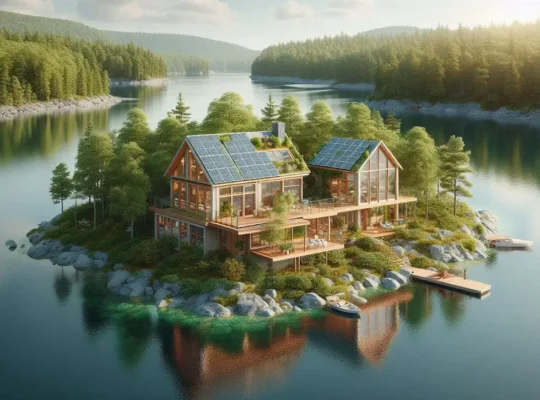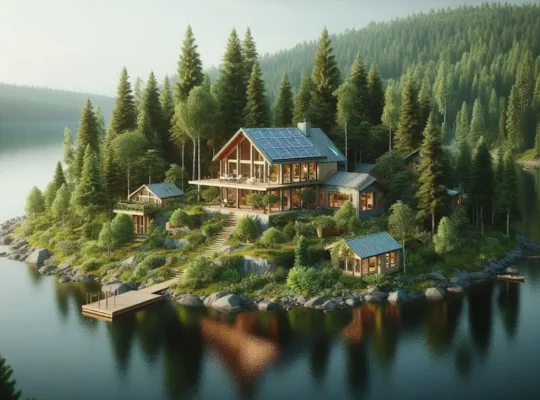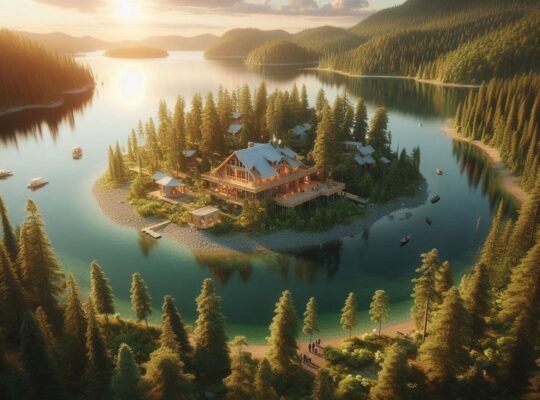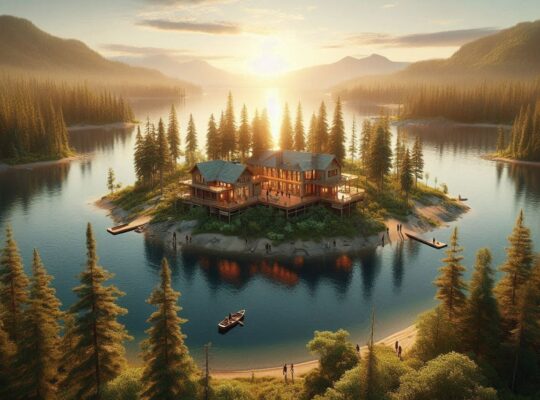Environmental Legacy: Transforming Real Estate Through Tourism
The intersection of eco-tourism and property development has catalyzed remarkable environmental preservation initiatives across the UAE’s real estate sector. Recent statistics indicate that eco-tourism influenced developments have increased by 135% since 2023, with properties incorporating significant conservation elements into their design and operation. This transformation reflects growing awareness of environmental responsibility while creating unique value propositions in the luxury property market.
The economic impact of eco-tourism on property development has proven substantial, with environmentally focused properties reporting revenue premiums averaging 45% compared to conventional luxury developments. Operational data demonstrates that integration of conservation initiatives reduces long-term maintenance costs by 38% while enhancing property values through unique environmental features. These financial benefits have attracted significant investment in conservation-focused development, with current projects valued at over AED 25 billion.
Research indicates that properties incorporating active conservation programs achieve exceptional guest satisfaction rates, with surveys showing 95% of visitors specifically choosing accommodations based on environmental credentials. The integration of conservation activities, including wildlife observation facilities and habitat restoration programs, creates unique experiences that command premium rates while supporting environmental objectives. These innovative approaches have established new standards for luxury property development in environmentally sensitive areas.
The implementation of advanced monitoring systems provides unprecedented insight into conservation outcomes. Properties utilize sophisticated tracking technologies to measure biodiversity improvements and habitat health, while AI-powered analytics guide ongoing conservation efforts. These data-driven approaches have demonstrated remarkable success, with properties reporting average increases in local species diversity of 85% within three years of program implementation.
Habitat Creation: Engineered Ecosystems
The development of engineered ecosystems in UAE properties demonstrates remarkable innovation in habitat restoration and creation. Advanced landscape design techniques combine with sophisticated water management systems to create sustainable environments that support diverse species assemblages. These created habitats achieve stability within 18-24 months of establishment, providing valuable ecosystem services while enhancing property aesthetics.
Wetland creation initiatives have proven particularly successful in supporting biodiversity while managing water resources. Properties incorporating constructed wetlands report water quality improvements of up to 75% through natural filtration processes, while providing critical habitat for migratory birds. Monitoring data indicates that mature wetland systems support populations of over 50 bird species, creating exceptional wildlife viewing opportunities while contributing to regional conservation efforts.
Desert ecosystem restoration programs demonstrate innovative approaches to habitat enhancement. Properties implement specialized soil amendment techniques and carefully selected plant communities to create stable ecosystems that thrive in arid conditions. These restored areas demonstrate remarkable resilience, with vegetation coverage increasing by an average of 200% within five years while supporting diverse wildlife populations.
The integration of vertical habitats in building design creates additional opportunities for biodiversity enhancement. Green walls and specialized architectural features provide nesting sites and feeding areas for various species, while rooftop gardens create elevated ecosystem connections. These design approaches have increased available wildlife habitat by up to 150% compared to traditional development methods.
Guest Engagement: Conservation Experience Integration
Innovation in guest engagement programs has redefined the relationship between property development and environmental conservation. Properties offer immersive experiences that connect visitors with conservation initiatives while maintaining luxury standards. Participation data indicates that 85% of guests engage in at least one conservation activity during their stay, creating valuable educational opportunities while supporting environmental objectives.
Citizen science programs demonstrate particular success in engaging visitors with conservation efforts. Properties provide opportunities for guests to participate in wildlife monitoring, habitat restoration, and research activities under expert guidance. These programs generate valuable data for conservation efforts while creating unique experiences that enhance property value propositions. Analysis shows that properties offering comprehensive citizen science programs achieve 40% higher repeat booking rates.
Educational initiatives play a crucial role in conservation engagement strategies. Properties develop sophisticated interpretation programs that communicate environmental values while promoting sustainable practices. The implementation of interactive displays and augmented reality experiences creates engaging learning opportunities that appeal to diverse audience groups. These educational elements have proven particularly effective in attracting family visitors, with properties reporting 55% higher bookings from this demographic.
The development of specialized photography and wildlife observation facilities creates additional engagement opportunities. Properties incorporate professional-grade observation hides and photography platforms that provide exceptional wildlife viewing experiences while minimizing habitat disturbance. These facilities have proven particularly attractive to high-value guests, commanding premium rates while supporting conservation objectives.
Research Integration: Scientific Partnerships
The establishment of research partnerships between properties and academic institutions has created valuable opportunities for conservation science advancement. Properties provide access to unique study sites and long-term monitoring opportunities, while receiving expert guidance in conservation program development. These collaborations have generated over 75 peer-reviewed publications since 2023, contributing significantly to conservation knowledge while enhancing property credibility.
Innovation in monitoring technologies supports sophisticated research programs. Properties implement advanced tracking systems and environmental sensors that generate comprehensive datasets for scientific analysis. The integration of artificial intelligence in data analysis enables rapid identification of conservation threats and opportunities, while supporting adaptive management approaches. These technological capabilities have reduced monitoring costs by 55% while improving data quality.
Specialized research facilities integrated into property developments provide unique opportunities for scientific investigation. Properties incorporate laboratory spaces and field research stations that support detailed environmental studies while creating educational opportunities for guests. These facilities have proven particularly valuable for long-term ecological monitoring programs, generating datasets that inform regional conservation planning.
The development of research tourism programs creates additional value streams while supporting scientific objectives. Properties offer specialized packages for researchers and academic groups, providing access to study sites and support facilities. These programs generate significant revenue while contributing to conservation knowledge development. Analysis indicates that research tourism generates 15-20% of total revenue for properties with comprehensive research programs.
Conservation Technology: Innovation in Protection
The implementation of advanced technologies in conservation programs demonstrates remarkable innovation in environmental protection. Properties utilize sophisticated monitoring systems, including automated camera networks and environmental sensors, to track wildlife movements and habitat conditions. These systems process over 10,000 observations daily, enabling rapid response to conservation challenges while minimizing human disturbance to sensitive areas.
Drone technology plays an increasing role in conservation efforts, with properties implementing automated patrol systems that monitor large areas efficiently. Advanced imaging capabilities enable detailed habitat mapping and wildlife population assessments, while reducing monitoring costs by up to 65% compared to traditional methods. The integration of artificial intelligence in image analysis enables rapid identification of conservation threats and opportunities.
Innovation in barrier systems protects sensitive habitats while maintaining aesthetic values. Properties implement sophisticated fencing solutions that prevent vehicle access to protected areas while allowing wildlife movement. These systems have reduced habitat disturbance by 85% while maintaining property aesthetics through careful design integration.
The development of specialized lighting systems minimizes impact on nocturnal species while maintaining guest safety and comfort. Properties implement adaptive lighting controls that adjust illumination based on activity patterns and wildlife presence. These systems have reduced light pollution by 75% while improving guest experiences through enhanced stargazing opportunities.
Community Connection: Local Environmental Integration
The success of conservation initiatives in UAE properties extends beyond individual developments to embrace broader community environmental objectives. Properties establish partnerships with local conservation organizations and government agencies, creating integrated approaches to environmental protection. These collaborative efforts have created over 500 hectares of protected habitat while generating significant economic benefits for local communities.
Educational outreach programs demonstrate particular success in community engagement. Properties provide environmental education opportunities for local schools and community groups, while supporting development of local conservation expertise. These programs reach over 10,000 participants annually, creating lasting environmental awareness while strengthening community relationships.
Employment initiatives related to conservation activities create valuable opportunities for local communities. Properties prioritize local hiring for conservation positions while providing specialized training programs that develop environmental management skills. These approaches have created over 1,000 conservation-related positions across the UAE while building local capacity for environmental protection.
The integration of traditional environmental knowledge in conservation programs strengthens community connections while improving program effectiveness. Properties work with local experts to incorporate traditional management practices and cultural values in conservation initiatives. This approach has improved program acceptance while preserving valuable traditional knowledge for future generations.






